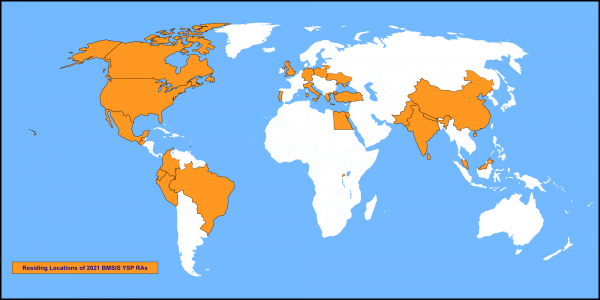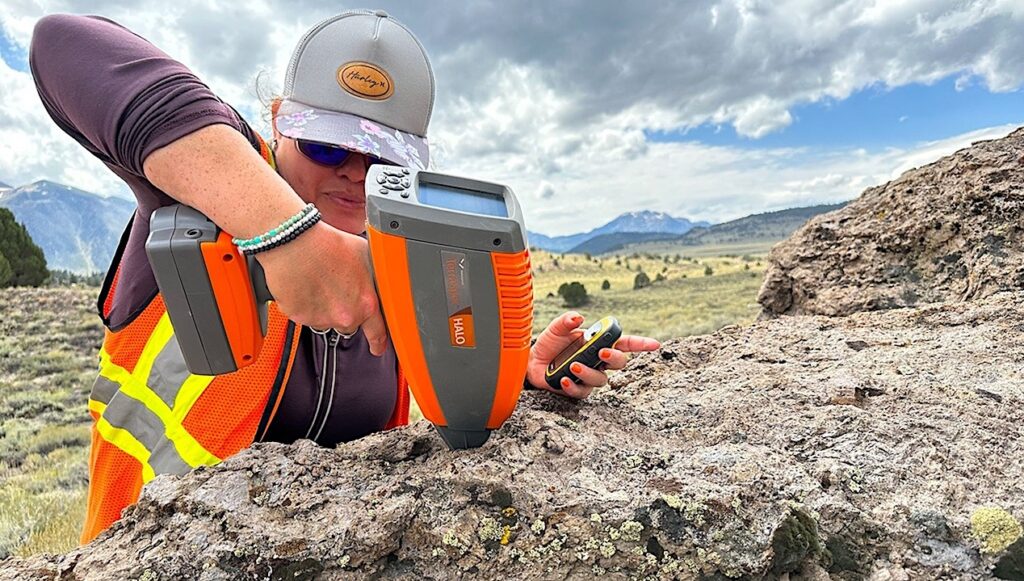Life Detection Techniques Inspired By Developments And Tools In Physical And Biological Sciences

Human imagination has long been captivated by the pursuit of life outside of Earth. Is life a phenomenon that extends beyond the limits of Earth, or are humans alone in the vastness of the cosmos?
A team of undergraduate students, supervised by three astrobiologists (one of which is an ELSI researcher), presents a primer on methods to uncover extraterrestrial life through life detection technologies. From investigating Earth to exploring the solar system to studying exoplanets, the lines between distinct disciplines necessarily blur in this pursuit as cutting-edge tools and fresh ideas from different fields emerge and combine, fundamentally altering the perception of and ability to detect life’s existence beyond Earth.

Image 1: Location of the 2021 BMSIS YSP Fellows, showing significant participation from around the world. Credit: Graham Lau and BMSIS.
The challenging task of life detection necessitates scientific rigour, fascination, and curiosity. It drives us to test the limits of the understanding of life and discover uncharted territory, both on and off of Earth. Understanding the plausibility of life off of Earth is built on traditional approaches from various astrobiology-related disciplines, such as the examination of extraterrestrial environments capable of harbouring life or seeking to detect biosignatures on other planets.
But as science and technology develop further, and awareness of the universe expands, new methods from a variety of fields, especially those in the biological and physical sciences, are being employed to reveal buried clues and solve the mystery of life’s existence in the cosmos. In this prospective review, the authors review novel and established techniques in life detention drawn from distinct realms of physical and biological sciences whose applications are now not limited to only a few scientific disciplines.
The review presents numerous cutting-edge life detection methods that have emerged due to the fusion of physical and biological sciences with astrobiology. These techniques can be roughly categorized into solar system-based, exoplanet-based, and technosignature-based. For example, established solar system-based techniques include gas chromatography and Raman spectroscopy, which have previously proven useful in the analysis of extraterrestrial minerals and volatile substances during planetary missions. However, this review proposes other novel techniques to be incorporated into solar system-based life detection technologies.
One such technique is the direct sequencing of nucleic acids and peptides off of Earth, which may be possible without the need for laborious sample preparation could be possible with further development of nanopore sequencing (first developed for genomics), especially the incorporation of quantum tunnelling techniques. Laser-induced breakdown spectroscopy makes use of concentrated laser pulses to examine the elemental makeup of materials and reveal the existence of biomolecules. Digital holographic microscopy (DHM) has also recently attracted interest in the field of astrobiology for the in-situ imaging of astrobiological microbes in plume samples from icy moons in the solar system due to its non-destructive nature and is a promising technique for identifying agnostic biosignatures such as “life-like” physical characteristics like mobility.
Ice core analysis is another method currently used on Earth, which could reveal the atmospheric chemical composition through the history of Earth if more advanced coring techniques can be developed. The integration of X-ray diffraction (XRD) analysis and nuclear magnetic resonance (NMR) spectroscopy, typically used in structural biology and other chemistry/biology-based applications, is one newly proposed combination of techniques that offers an intriguing approach to expanding understanding of the chemical and structural makeup of extraterrestrial samples.
While NMR spectroscopy may investigate molecules in solution or the solid state without the necessity for crystallization, XRD provides detailed information about crystalline structures. This integrative method, which enables the examination of aqueous samples and offers insights into mineralogy, aqueous geochemistry, and possible biosignatures, can be particularly useful for in situ detection of potential biosignatures in the ocean worlds such as Europa.

Image 2: Kick-off Meeting of the 2021 BMSIS YSP Program, which featured 126 enrolled YSP fellows. The project team, led by Dr. Graham Lau, Dr. Chaitanya Giri, and Dr. Tony Z. Jia had 11 YSP fellows finish the program, leading to this publication.
Since current explorations of exoplanets mainly rely on remote observations, the primer also highlights the significance of observational and computational methodologies for discovering biosignatures in exoplanets, particularly exoplanet atmospheres. A possible biosignature can be created by chemical imbalances that result from biological and metabolic processes, and thus differential compounds in the atmospheres of exoplanets can be identified using remote sensing methods like high-resolution transmission spectroscopy.
Knowledge of exoplanetary atmospheres could be expanded by future observatories equipped with higher-resolution spectrometers that can detect numerous gases at once in the mid-infrared and ultraviolet range. Another method of remote detection that can be used to discover surface waters and gather vital data for the search for life is the orbital fluctuation in reflected starlight. Oceanic features may be identified, and inhabited worlds can be described by utilizing polarization measurements and mapping specular reflections. This subject will advance thanks to improvements in high-contrast space-based telescopes, as well as sophisticated oceanography and biosignature research.
Finally, the development of cutting-edge wireless methods of laser communication holds promise for technosignature detection. When compared to traditional radio frequency communication, laser communication employs photons packed with data to provide quicker transmission speeds and bigger data quantities.
Improved security, dependability, and flexibility are all provided by laser communication, which also enables small, lightweight communication terminals with low power needs. Laser communication technology is highly suited for future missions demanding high-speed and long-distance data transmission for life detection and deep space exploration since it can carry data at rates up to 100 times higher than present deep space communication technologies.
Thus, in an attempt to shed light on potential novel approaches in life detection, the authors of this primer combine their broad spectrum of knowledge and prior research in the biological and physical sciences with needs in life detection within the astrobiology field. Co-author and writer of this research highlight, former BMSIS YSP fellow and project member Kashish Gupta, says, “The future of life detection holds endless potential as we advance on the frontiers of interdisciplinary science. Our perception and understanding of the plausibility of life beyond Earth can be fundamentally altered by developments in the highlighted cutting-edge technologies, interdisciplinary synergy, and unwavering curiosity.”
This review was a culmination of a project as part of the 2021 Blue Marble Space Institute of Science (BMSIS) Young Scientist Program (YSP), co-led by Dr. Graham Lau (BMSIS), Dr. Chaitanya Giri (FLAME University), and Dr. Tony Z. Jia (ELSI/BMSIS), which had 11 fellows, including Gupta, complete the program. In total, the 2021 BMSIS YSP program drew 126 fellows from around the world; this significant global participation shows the interest of many young aspiring researchers from many countries, which will undoubtedly lead to a bright future for the field of space sciences.
This ELSI Research Highlight is compiled by Kashish Gupta and Tony Z. Jia.
Journal Space: Science and Technology
Title of the paper Applying Novel Techniques from Physical and Biological Sciences to Life Detection
Authors Tony Z. Jia1,2,, Chaitanya Giri3,4, Andrea Aldaba2, Ilknur Bahcivan2, Nipun Chandrasiri2, Ilankuzhali Elavarasan2, Kashish Gupta2, Sakshi P. Khandare2, Christos Liaconis2, Arpita Saha2, Orlando J. Solórzano2,4, Paola I. Tiranti2, Aivaras Vilutis2, Graham E. Lau2,*
Affiliations 1. Earth-Life Science Institute, Tokyo Institute of Technology, 2-12-1-IE-1 Ookayama, Meguro-ku, Tokyo 152-8550, Japan.
- Blue Marble Space Institute of Science, 600 1st Ave, Floor 1, Seattle, WA, 98104 USA.
- Research and Information System for Developing Countries (RIS), Core IV-B, Fourth Floor, India Habitat Centre, Lodhi Road, New Delhi 110 003, India
4.Department of Physical and Natural Sciences, School of Liberal Education, FLAME School for Liberal Education, FLAME University, Lavale, Pune, 412115, Maharashtra, India.
- School of Physical Sciences and Nanotechnology, Yachay Tech University, 100119, Urcuquı́, Ecuador.
DOI 10.34133/space.0040
Online published date 17 May 2023








